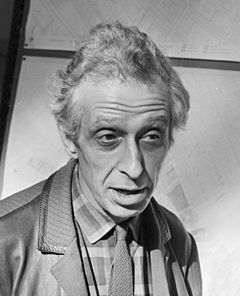Aldo van Eyck
Aldo van Eyck | |
|---|---|
 Aldo van Eyck in 1970 | |
| Born | (1918-03-16)16 March 1918 Driebergen, Netherlands |
| Died | 14 January 1999(1999-01-14) (aged 80) Loenen aan de Vecht, Netherlands |
| Nationality | Dutch |
| Alma mater | ETH Zurich |
| Occupation | Architect |
Aldo van Eyck (Dutch pronunciation: [ˈɑldoː vɑn ˈɛik]; 16 March 1918 – 14 January 1999[1]) was an architect from the Netherlands. He was one of the most influential protagonists of the architectural movement Structuralism.
Contents
1 Family
2 Early life and career
3 Later career
4 Selected works
5 References
Family
He was born in Driebergen, Utrecht, a son of poet, critic, essayist and philosopher Pieter Nicolaas van Eyck or van Eijk and wife Nelly Estelle Benjamins, a woman of Sephardic origin born and raised in Suriname.[2][3][4]
His brother was poet, artist and art restorer Robert Floris van Eyck or van Eijk. He was married to Hannie van Rooijen, also an architect. She assisted him in several projects.[5]
Early life and career
His family moved to the United Kingdom in 1919 and he was educated at Sidcot School, Somerset, from 1932 to 1935, after which he finished his secondary school in The Hague between 1935 and 1938, and went to study at the ETH Zurich. He graduated in 1942, after which he remained in Switzerland until the end of World War II, where he entered the circle of many other avant-garde artists around Carola Giedion-Welcker, wife of historian Sigfried Giedion.
He taught at the Amsterdam Academy of Architecture from 1954 to 1959 and he was a professor at the Delft University of Technology from 1966 to 1984. He also was editor of the architecture magazine Forum from 1959 to 1963 and in 1967.
Later career
A member of CIAM and then in 1954 a co-founder of "Team 10", Van Eyck lectured throughout Europe and northern America propounding the need to reject Functionalism and attacking the lack of originality in most post-war Modernism. Van Eyck's position as co-editor of the Dutch magazine Forum helped publicise the "Team 10" call for a return to humanism within architectural design.
Van Eyck received the RIBA Royal Gold Medal in 1990.
He died at Loenen aan de Vecht, aged 80.
Selected works

Municipal Orphanage in Amsterdam, 1960 (Aldo van Eyck)
- Design for village of Nagele, Noordoostpolder, 1948–1954
- Housing for the Elderly, Slotermeer, Amsterdam, 1951–1952
Amsterdam Orphanage, Amsterdam, 1955–1960- Primary Schools, Nagele, Noordoostpolder, 1954–1956
Hubertus House, Amsterdam, 1973–1978
ESA-ESTEC restaurant and conference centre, Noordwijk, 1984–1990
References
| Wikimedia Commons has media related to Aldo van Eyck. |
^ "Aldo van Eyck". Team 10 On line. Retrieved 9 September 2012..mw-parser-output cite.citation{font-style:inherit}.mw-parser-output .citation q{quotes:"""""""'""'"}.mw-parser-output .citation .cs1-lock-free a{background:url("//upload.wikimedia.org/wikipedia/commons/thumb/6/65/Lock-green.svg/9px-Lock-green.svg.png")no-repeat;background-position:right .1em center}.mw-parser-output .citation .cs1-lock-limited a,.mw-parser-output .citation .cs1-lock-registration a{background:url("//upload.wikimedia.org/wikipedia/commons/thumb/d/d6/Lock-gray-alt-2.svg/9px-Lock-gray-alt-2.svg.png")no-repeat;background-position:right .1em center}.mw-parser-output .citation .cs1-lock-subscription a{background:url("//upload.wikimedia.org/wikipedia/commons/thumb/a/aa/Lock-red-alt-2.svg/9px-Lock-red-alt-2.svg.png")no-repeat;background-position:right .1em center}.mw-parser-output .cs1-subscription,.mw-parser-output .cs1-registration{color:#555}.mw-parser-output .cs1-subscription span,.mw-parser-output .cs1-registration span{border-bottom:1px dotted;cursor:help}.mw-parser-output .cs1-ws-icon a{background:url("//upload.wikimedia.org/wikipedia/commons/thumb/4/4c/Wikisource-logo.svg/12px-Wikisource-logo.svg.png")no-repeat;background-position:right .1em center}.mw-parser-output code.cs1-code{color:inherit;background:inherit;border:inherit;padding:inherit}.mw-parser-output .cs1-hidden-error{display:none;font-size:100%}.mw-parser-output .cs1-visible-error{font-size:100%}.mw-parser-output .cs1-maint{display:none;color:#33aa33;margin-left:0.3em}.mw-parser-output .cs1-subscription,.mw-parser-output .cs1-registration,.mw-parser-output .cs1-format{font-size:95%}.mw-parser-output .cs1-kern-left,.mw-parser-output .cs1-kern-wl-left{padding-left:0.2em}.mw-parser-output .cs1-kern-right,.mw-parser-output .cs1-kern-wl-right{padding-right:0.2em}
^ Wage, H.A. (1979) "Eijk, Pieter Nicolaas van (1887–1954)" in Biografisch Woordenboek van Nederland
^ Eilers, Marlene A. (1987) Queen Victoria's Descendants, Baltimore, Maryland: Genealogical Publishing Co.,
ISBN 9163059649, p. 167
^ Fernández-Galiano, Luis (16 January 1999) Fallece Aldo van Eyck, arquitecto clave del estructuralismo holandés. El Pais
^ "Aldo van Eyck". Team 10 On line. Retrieved 9 March 2013.